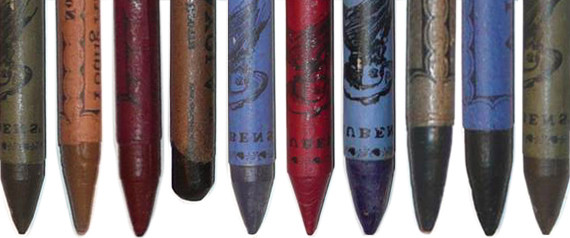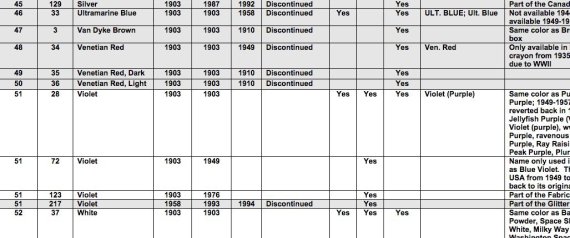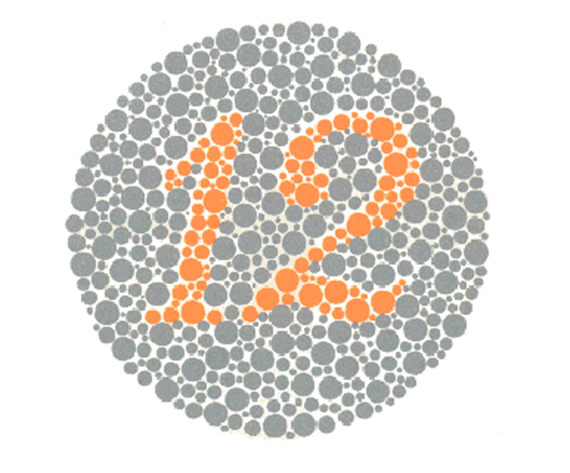What Did Crayola Name The Flesh Color Crayon

Few things stir upwards childhood nostalgia as quickly equally a fresh box of crayons. Information technology's easy to see what makes them an highly-seasoned collectors' particular. For Ed Welter, a sometime Nike project director from Oregon, the allure went a pace further.
No one, non even Crayola, had recorded a total history of crayons. So it became Welter'due south claiming.
As a devoted collector, he began focusing on crayons effectually 2000, soon afterwards selling off an extensive beer-can collection. Welter gathered box later box, with some dating back to the 1880s. Old catalogs from libraries effectually the state (and, later, on Google Books) allowed him to cobble together a timeline. By 2014, Welter had amassed over 3,000 boxes of colored wax, about half of which were Crayola. So he sold everything (Crayola purchased its namesake boxes while the others went to various collectors) and retired to Spain.
What Welter had discovered in his 14 years of collecting is that Crayola's color history is absurdly complicated. On his website, Crayon Collecting, Welter laments how singlehandedly piecing it all together was difficult not only "just from the sheer corporeality of detail, just also because of the convoluted swapping and renaming of colors." For example, the crayon which the company named "Blueish" when it got its start in 1903 was non the same "Blue" by the 1930s. It was given a new name, which no longer exists today, and "Blue" became a brighter shade of the colour.
Dislocated? It's okay. Information technology took near eight whole months for Welter to piece together Crayola's history, which he described to The Huffington Post equally "complex" and, pun intended, "colorful."
There are crayon colors that no longer exist today, many of them coming from old painters' palettes.
In essence, Crayola became such a hitting because the company figured out a mode to inexpensively combine methane series wax with safe pigments, according to Welter. Colors in the early years drew from paints available from fine art suppliers at the fourth dimension, and many of these shades have since dropped out of production.
Amidst the original shades that take been unceremoniously discontinued, according to Welter's research: Burnt Umber, Celestial Bluish, Charcoal Grey, Cobalt Blue, English Vermillion, Madder Lake, Ultramarine Blue, Van Dyke Dark-brown and Venetian Red. Raw Sienna lives on in name, but as a different shade of brown than its predecessor. Crayola officially "retired" Raw Umber in 1990 along with seven other shades. Nonetheless others have dropped out without so much every bit a goodbye.

Original Crayola shades that accept been discontinued. Courtesy Ed Welter.
"New" Crayola crayons aren't frequently new, just renamed. By 2013, Welter had counted 755 colour names that had e'er been sold, but just 331 individual colors.
In 1903, the visitor used 54 names for 38 split up colors. Past the end of 1958, the company had created 138 names for 108 colors sold at any point in fourth dimension. By 2015, information technology had bestowed 759 names upon 331 colors.
Special crayon boxes with colors like Iron Man Blue and Liberty Blueish are just the plain old Blue you lot'd find in any regular box. Sugariness Georgia Peach is really but Melon. Tye Dye Lime is Green Xanthous. (Crayola might be on to something, though, for wanting to keep things simple.)

Blueish and cerise shades from Crayola's early years, compared. Courtesy Ed Welter.
Crayola once issued a box with several crayons of the aforementioned color under different names.
In 1949, Crayola debuted a new 48-count box of crayons, filled with lies.
"They pulled a fast one on everybody," Welter wrote on his site. Light Turquoise Blue and Turquoise Blue wait identical, as do Dark Dark-green and Dark-green. And expert luck figuring out the difference betwixt Bright Rose, Medium Rose and Light Magenta. Or Medium Violet and Violet.

Courtesy Ed Welter.
Certain colors accept been renamed for political reasons, like "Flesh."
What colour is flesh? According to Welter, it's the lightly pigmented, roughly universal shade we run across on our palms -- like the Crayola crayon by that proper noun. For most people, yet, flesh refers to skin tone, and the problem with making one beige-y shade the only pare-tone crayon available is obvious. But until the early 1960s, Welter explained, the company hadn't withal realized how the name could crusade consternation. A social researcher noticed children using the shade to depict people, teasing darker-skinned classmates who didn't match the crayon. Shortly after the researcher wrote a letter to the company in 1962, (after a couple back-and-along years with the name Pink Beige, for some reason) the Crayola shade became known as Peach.
Indian Red was also renamed, though not until 1999. The name actually referred to a pigment from a plant found in India, Welter told HuffPost, and could have been tweaked to "Bharat Red." To avoid misconceptions, yet, the visitor chose a completely new -- and completely neutral -- name: Chestnut.

"Mankind" or "Peach"? Courtesy Ed Welter.
The Macaroni and Cheese crayon was named past a pasta-loving vi-year-old.
For much of the visitor'south history, Crayola'southward crayon names were plain. Then in 1983, a new line for pocket-sized children with names similar Birdie Blue and Kitty Cat Blackness was introduced. Metallics, like Tiger Heart and Moonstone, followed a few years later with other specialty crayons. And, in 1992, the company opened up naming rights to anyone. Fans of all ages got the chance to name 16 brand-new colors -- which Welter says were, indeed, not recycled from by boxes.
"I wrote a letter to Crayola (all by myself, a proud half dozen-year-quondam), entering the contest," a grown-upwardly Adrienne Watral told The Huffington Mail in an email. When she found out that her submission had won a calendar month later, the crayon company flew Watral'south whole family unit out to Hollywood, showering them with "enough Crayola swag to final a lifetime." And the new orange crayon had a proper name: Macaroni and Cheese. "I remember being interviewed for various news stations on tv and being asked how I thought of the proper name," she wrote. "This was the easiest question ... I named the color of my favorite food!"
Another famous colour was named by a 12-year-old Sam Marcus, who drew small facial expressions to correspond with each new crayon. His "laughter" face was colored pink because, Marcus told HuffPost in an electronic mail, he'd blush when someone tickled him as a kid. Hence Tickle Me Pink was built-in.
We'd also similar to annotation that Royal Mount's Majesty was named by an 89-year-old Mildred Samson -- proving that coloring knows no boundaries.

Adrienne Watral with her winning crayon. Courtesy photo.
Despite all the changes, Welter says the colour quality has remained fairly consistent throughout the past century.
The biggest overall modify, Welter explained, happened subsequently World War Ii, when many of the paint suppliers Crayola had been using for years could no longer sell to the company. Either the supply had been ruined or the account had altered, putting the company in the odd position of finding new and e'er-so-slightly-dissimilar sources.
"You lot know how people are with, 'Oh, back in my day, colors were so much richer!'" Welter told HuffPost. "But I actually colored on paper with all of them." By and large, there were simply very gradual changes, similar the new pigments and perhaps minor tweaks to different formulas. "Since the '60s, they've kept pretty true to their basic colors."

Click to view the complete color nautical chart
As for Welter, he now spends his fourth dimension "virtually collecting" crayons by digging up information and fixing inaccuracies around the Net. He warns that Wikipedia is specially inaccurate when it comes to Crayola, but since the site does not let contributors to cite their own enquiry, the faux information remains unchecked. It bothers him, but not enough to stop his efforts.
"When you're a collector," he said, "you're in it for the minutia."
Description: An earlier version of this post misidentified the social researcher who lobbied to modify the Flesh crayon as a Crayola employee. She was not employed by the company.

Are Y'all Colorblind?
What Did Crayola Name The Flesh Color Crayon,
Source: https://www.huffpost.com/entry/crayola-crayon-color-history_n_7345924
Posted by: daughertyreteneve.blogspot.com


0 Response to "What Did Crayola Name The Flesh Color Crayon"
Post a Comment